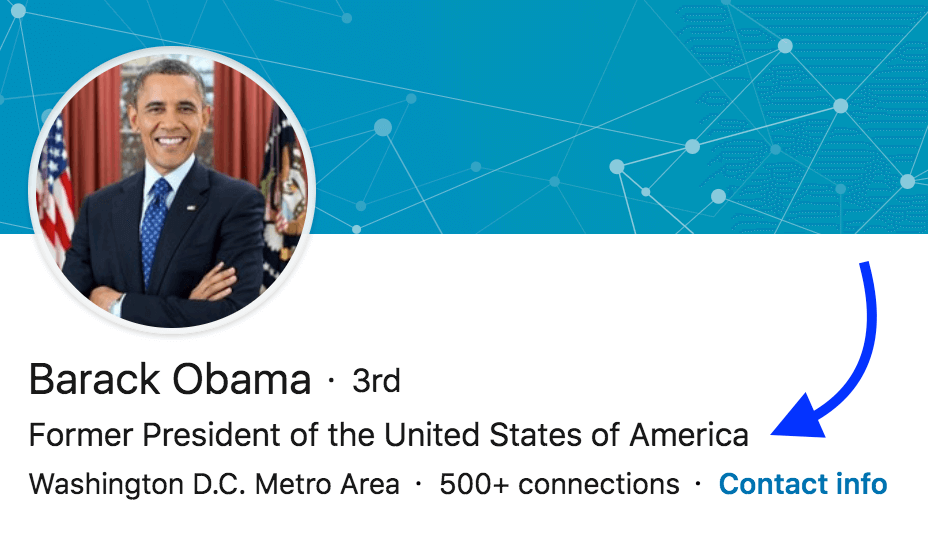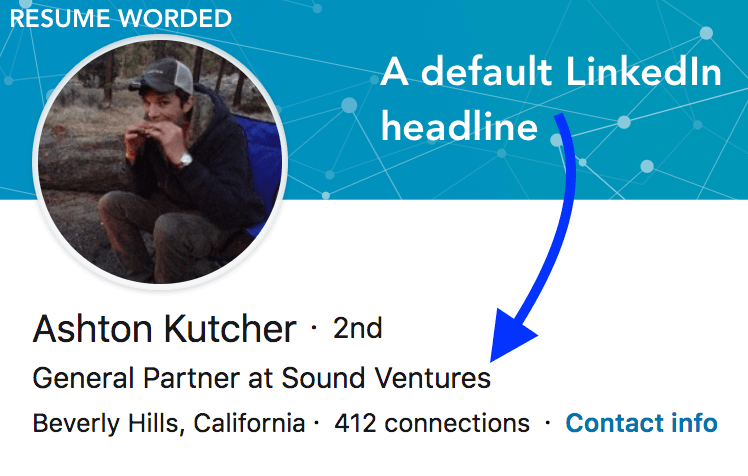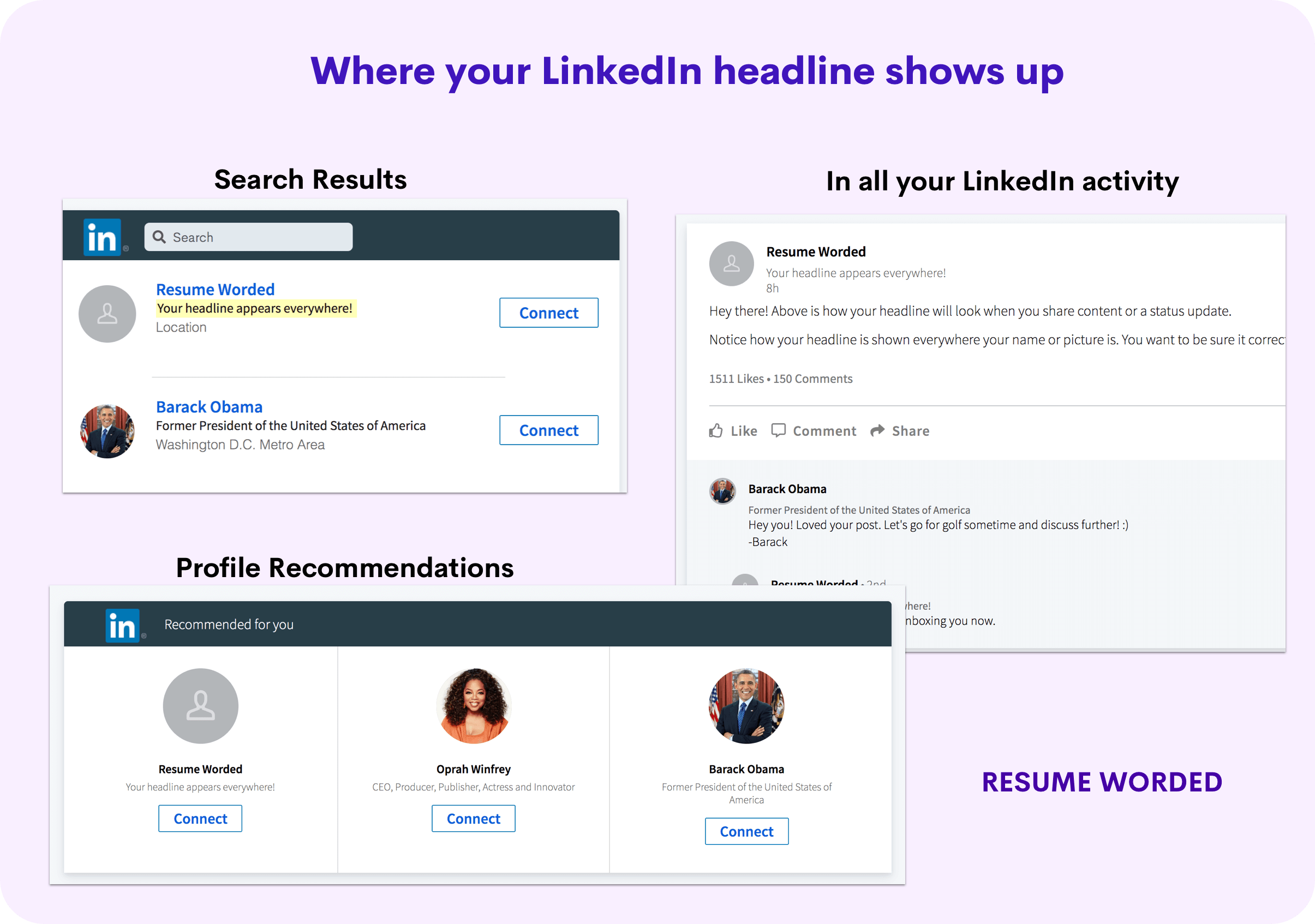LinkedIn Headline Generator
Generate unlimited examples of effective LinkedIn headlines instantly. Use them as inspiration when creating your own headline. For free.
or learn more

What is your LinkedIn headline?
Your LinkedIn headline is the most seen component of your LinkedIn profile. It appears everywhere your name does and gives recruiters and potential prospects a quick overview of who you are and why they should click into your profile. Here's what Obama's headline looks like.
By default, LinkedIn sets your headline as your current job title and company you work at. Here's an example of Ashton Kutcher's headline:
His LinkedIn headline is in the default format, and is not optimized.
Like Ashton, most people leave their headline as the default, either because they don't know it can be changed or they are not sure why they should change it. In the following sections, we'll explain exactly what a strong LinkedIn headline will do for you and examples of headlines you can use.
Why is your LinkedIn headline so important?
Your LinkedIn headline is prime marketing real estate - it appears everywhere your name and picture does, whether that's in search results, posts you comment on, or messages you send on LinkedIn.
We've put together this infographic to give you an idea of how your headline appears across LinkedIn.
That means that whenever a potential recruiter or prospect comes across your profile, the first thing they will see is your headline. It not only is the ultimate first impression, it also acts as a marketing tool to tell people why they should connect and follow you.
Let's look at an example.
Imagine that you are one of the millions of recruiters who use LinkedIn to find potential hires.
In this example, you are looking to hire a marketer with social media experience.
Like most recruiters, the first thing you'll do is to go on LinkedIn and
search for a keyword like, "marketing". This next screenshot is an excerpt of what your search results might look like.
Which profile would you click into?
If you are like most recruiters, you would reach out to Thomas. He not only seems more relevant (he has the keyword 'social media') but also has an impressive accomplishment in his headline: He's grown a Shopify store to 1M Visitors.
Thomas nailed his LinkedIn headline. Not only does the headline improve his first impression, it makes me as a recruiter already want to learn more and even interview him. That's just one reason why your LinkedIn headline is so important. It entices people to click into your profile and reach out to you. This directly means more opportunities, whether that's jobs or internships or clients.
Before we move on to the next section, try our free LinkedIn headline generator. This tool generates hundreds of examples of great LinkedIn headlines you can use on your LinkedIn profile.
What are keywords and why do they matter?
Getting people to click into your profile is just one reason why it's important to have a great LinkedIn headline. The second reason is even more important: a good LinkedIn headline results in you showing up higher in search results.
If you've ever done a search for a job title on LinkedIn (e.g. 'Java Developer'),
you'll notice that LinkedIn quickly searches through their database of 500 million (!) users and finds you 500 thousand relevant people that are Java Developers.
Have you ever wondered how LinkedIn ranks those 500,000 profiles in seconds?
LinkedIn essentially searches these profiles for the search terms, or 'keywords', (i.e. in this case 'Java Developer'). If you didn't have the same keywords
in your headline as the recruiter's search query, LinkedIn won't show your profile to the searcher (e.g. recruiter). This is because your profile appears less relevant than someone
who does have those keywords in their profile.
The headline is one of the most important places LinkedIn looks at when ranking profiles.
This means that LinkedIn looks at your headline to decide whether or not to show you in search results.
How to use keywords to optimize your headline
Our recommendation is to use keywords in your headline that you expect recruiters and your prospects to search for. That way, you're increasingly likely to appear in search results when someone types in those keywords.
If you're a job seeker, keywords that you can add are variations of the job title that you want to be hired for. For example,
if you want to be a social media manager, you could include phrases like "Freelance Social Media Manager" into your headline.
Remember to be specific. Add in keywords, acronyms and certifications that are relevant to the job you are looking for (if you're a jobseeker), or
keywords that your buyers and prospects are likely to be searching for.
LinkedIn allows you to add in up to 120 characters in your headline - make
the most of it! Top LinkedIn headlines take advantage of this character limit and are typically 7 - 14 words long.
Remember: Keywords listed in your Headline will increase your ranking among other users for those search terms.
What makes a great LinkedIn headline? Here are some examples.
An Example LinkedIn Headline for Students
If you're a student or you've just graduated, be specific about the roles you want in your headline.
It's a wasted opportunity to say, "Graduate from XYZ University", since recruiters and hiring managers
are not searching for those terms. Instead, they're searching for terms such as "entry-level software developer".
You want to be sure you end up in search results when they search for those terms.
Generate more LinkedIn headlines like this one using our LinkedIn Headline Generator.
An Example LinkedIn Headline for an Experienced Hire
This candidate has clearly tailored his profile to opportunities he is looking for. He's added in a certification he has, the job title he wants ("Product Manager"), and keywords closely aligned with the role ('data', 'users'). He's described the impressive scale of products he's worked with in the past ('10M+') which also acts as a hook for recruiters to look into his profile further. It's also important to note that this is a great example of a headline one could use, even if they are not currently employed.








